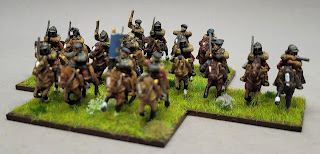The Gordon Horse
The Gordon Horse were originally raised for the Covenanters but changed sides and fought alongside Montrose. They then appeared to wage their own private war against anyone and everyone who wasn't a Gordon.
Lord George Gordon, 2nd Marquess of Huntly, was commissioned to raise a regiment of 8 troops for the Covenanters: they were raised in February 1643 in Aberdeenshire, Banffshire, Moray and Northern Scotland, they were based in Moray. They failed to appear at Berwick; parts of regiment join Callendar at Newcastle; Lewis would lead them at Aberdeen.
By February 1645 Lord Gordon changed sides to become Royalist: troopers from his Regiment of Horse either follow him or disperse. The now Royalist Regiment fought at Elgin; Dundee; Auldearn; Alford; Kilsyth; and Aberdeen.
That was the easy bit. Now for the complicated story of which Gordon was in command...
 |
| Lord George Gordon, 2nd Marquess of Huntly on display at Warwick Castle |
Lord George Gordon, 2nd Marquess of Huntly, gained military experience fighting for France in the 1630s against the Hapsburg Empire. He returned to Scotland just in time to join in the First Bishops' War; appointed King's lieutenant in northern Scotland he tried to rally support for the King with little success. He would journey to Edinburgh to negotiate with Montrose, which didn't go too well as he was arrested and imprisoned in 1639. He would be released upon the Pacification of Berwick, and return to his lands sitting out the Second Bishops' War.
When the Army of the Covenant marched south in 1644, he would seize Aberdeen for the King, but would flee to exile when the Covenanters turned their attention to him. His three sons would both fight with Montrose. George would be captured and executed in 1649.
Lord George Gordon, 2nd Marquess of Huntly, commanded the Regiment in name only: field command was left to his three sons. The timeline of the brothers' command of the Regiment is a bit of a moveable feast: there does not seem to be a direct linear progression from eldest to youngest, it is almost as though they randomly took it in turns.
His eldest son, confusingly called George Gordon, or even more confusingly Lord Gordon, would fall in battle at Alford July 1645.
Family loyalties and the politics of the Scottish clans meant that the Gordon Horse and Montrose would part company in September 1645; they would take no part in Montrose's defeat at Philiphaugh. Things got even more complicated when Charles I sided with the Covenanters in 1646. Unsure of who was now the 'enemy' the Gordons took to the hills and waged their own guerrilla war in the Highlands. James Gordon, Viscount Aboyne would be captured in December 1647 by the now Royalist Covenanters, but would manage to escape and flee to exile in Paris. He would die of a fever in 1649.
Lewis Gordon, 3rd Marquess of Huntly, was named after Louis XIII of France: his father was commander of the Garde Écossaise (a bodyguard of Scots for the King of France).
At the outbreak of the First Bishops' War 13 year old Lewis sneaked out of Gordon Castle to the Highlands, where he raised a brigade of clansmen from his father's estates to fight the Covenanters. His first experience of war was at Megray Hill, where his Highlanders scattered in the face of enemy cannon fire.
Following the peace, Lewis travelled to France, where he enlisted as an ordinary pikeman in an infantry regiment, in order to learn soldiering from the ground up. After three years, he travelled to England, working his way north by serving on both sides in the English Civil War, first in the Royalist Army and then in the Scottish Covenanter forces of his uncle, the Earl of Argyll.
Eventually returning home, the sixteen-year-old nobleman seduced and married the fiancée of his absent elder brother, Viscount Aboyne. Going into exile after the defeat of the Royalists, he travelled again to France; in rapid succession, he succeeded his brother and father as Earl of Enzie and Marquess of Gordon, and by 1651, he was allowed to return to Scotland, even though he refused to conform to the Presbyterian Church of Scotland.
He died aged 26 or 27, leaving a young widow, three daughters, and a four-year-old son who would eventually become the 1st Duke of Gordon.
Oodles of headswaps here, partly because I really like the other Scottish harquebusiers that I have created before, plus an element of going to town with these as they are my last planned unit of figures for my Civil Wars project*.
* Although, having said that some more Parliamentarian and Royalist foot have just been prepped ready for painting. Coincidentally, I was perusing the Maverick Models website for some flags for these new units, and I noticed that my Army of Montrose flags appear in the new website's header.














SUperb figures and interesting historical background!
ReplyDeleteThanks Phil
DeleteBonny bonneted boys!
ReplyDeleteMust confess that this is one of my favourite units. Really enjoyed producing them. (My Covenanter harquebusiers were the same)
DeleteLovely looking Gordon horse, I'll get to them eventually once I've started on my Montrose force, nicely animated!
ReplyDeleteBest Iain
Thanks Iain. I really enjoyed painting them.
Delete